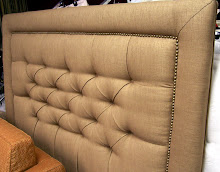 Why a green sofa?
Why a green sofa?The craft of custom upholstering gives you the choice of owning furniture that is comfortable and aesthetically pleasing, yet insures that you are surrounding yourself with materials that are healthy for you and the environment.
What is “comfort”? It varies from person to person. The perception of comfort changes with the use – what we find comfortable in a dining room or office or formal living room is not at all comfortable in the great room or media room. The style and sizing of the piece as well as the materials used all need to work in harmony to create a truly comfortable –really livable - piece of furniture.
There is no doubt - all of the options and benefits of a custom upholstered piece of furniture come at a higher up-front cost. But like our ancestors, shouldn’t we get back to the mind-set that furniture is meant to last a lifetime?
It is becoming more apparent that the chemicals that allowed for less expensive woods and materials to be used in our homes and furnishings have come at a long term cost – to our health and even to our pocket books. Overtime, many people have experienced an overload to their immune systems causing, among other things, higher rates of allergies and asthma in children. Additionally, products made from lower quality materials have a much shorter “shelf” life than those made from the old school methods. It’s hard to imagine that much of what we purchase at retail today will become tomorrow’s antiques. Yet, it is the antiques in our homes that are actually the “greenest” products we own. Made prior to the “chemical” revolution, antique furniture and rugs, made with all natural materials such as silk, cotton, wool, hardwoods and vegetable dyes, have lasted longer and are ultimately less expensive to the pocket book and the environment over their lifetime.

The Green Sofa by Heller Furniture is based on a design by Benjamin Thomson, FAIA, renowned architect and founder of Design|Research, Cambridge.
Available exclusively through Sedia, Inc. Boston.
























